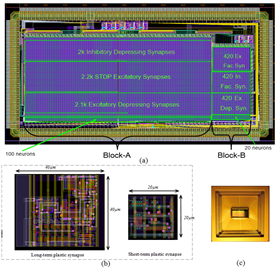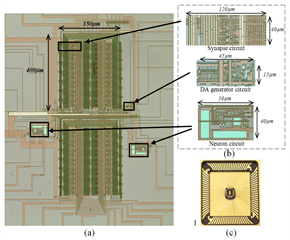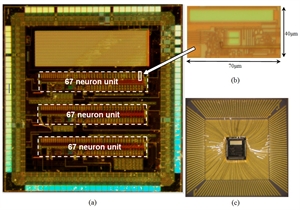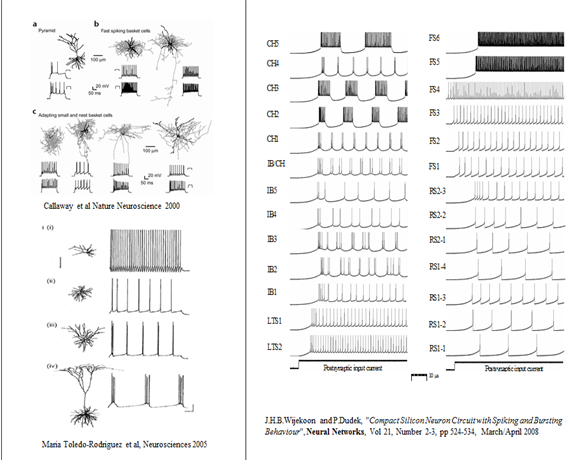
"Everything we call real is made of things that cannot be regarded as real." - Niels Bohr
Brain-Inspired VLSI Systems
Nature has evolved gifting remarkable cognitive abilities to the biological systems that enable animals to experience matter, feeling, perception, volitional formation and cognition while performing intelligent functions robustly. The computers process information fundamentally different to the biological systems. Advancement of modern computers has provided precise faster computing machines. Unfortunately, their ability to perform intelligent cognitive functions is nowhere close to biological systems. Therefore, with the aim of unravelling the mystery of biological computations and cognitive ability, our research at Manchester investigates sensors, sensory pathways and computational principles of biology by mimicking biological systems in hardware and by modelling higher-level cognitive functions in software.
Samples of Brain-Inspired Integrated Circuits (ICs):
We have been working with neurobiologist, neuroscientists, psychologists and computer scientists to investigate computational principles of biological neural networks by designing brain-inspired integrated systems. Samples of Integrated Circuits designed are listed below:
Cortical Neurons Silicon Cortical Neurons
Samples of Brain-Inspired Integrated Circuits (ICs):
We have been working with neurobiologist, neuroscientists, psychologists and computer scientists to investigate computational principles of biological neural networks by designing brain-inspired integrated systems. Samples of Integrated Circuits designed are listed below:
Cortical Neurons Silicon Cortical Neurons


Cortical Neocortical Layer (CNL) IC
This IC implements neural circuits with a similar cell composition to the neocortex. The CNL IC models 120 cortical neurons and 7,560 synapses. The IC comprises generic neuron and synapse circuits with configurable neuronal connections. The neurons of the IC can be configured to different known types of neurons. The IC is also equipped with short-term and long-term dynamic synapse circuits that include inhibitory, excitatory, facilitating and depressing and STDP dynamics. The implemented silicon neuron circuit produces biologically plausible action potentials and is capable of mimicking spiking and bursting firing patterns observed in cortical neurons, such as regular spiking, fast spiking, intrinsically bursting, chattering, etc.
This IC implements neural circuits with a similar cell composition to the neocortex. The CNL IC models 120 cortical neurons and 7,560 synapses. The IC comprises generic neuron and synapse circuits with configurable neuronal connections. The neurons of the IC can be configured to different known types of neurons. The IC is also equipped with short-term and long-term dynamic synapse circuits that include inhibitory, excitatory, facilitating and depressing and STDP dynamics. The implemented silicon neuron circuit produces biologically plausible action potentials and is capable of mimicking spiking and bursting firing patterns observed in cortical neurons, such as regular spiking, fast spiking, intrinsically bursting, chattering, etc.
Dopamine-Modulated (DA) Synapses IC
This IC contains twenty-eight STDP or DA-STDP synapses with a global DA generator circuit, and two cortical neuron circuits. The DA synapse circuit approximately implements the dynamics of the DA synapse proposed by Izhikevich (2007). The dynamics of the model, based on ‘eligibility traces’ generated according to an STDP rule, ensure that causal pre-/post- synaptic spiking activity in the time preceding the reward, signalled by DA, leads to a strengthening of the synaptic connections. This circuit block is a good candidate for the development of neuromorphic VLSI architectures that implement brain-inspired computation using biologically plausible reinforcement learning strategies. The synapses can be configured to work as an STDP synapse or as a DA-modulated STDP synapse.
This IC contains twenty-eight STDP or DA-STDP synapses with a global DA generator circuit, and two cortical neuron circuits. The DA synapse circuit approximately implements the dynamics of the DA synapse proposed by Izhikevich (2007). The dynamics of the model, based on ‘eligibility traces’ generated according to an STDP rule, ensure that causal pre-/post- synaptic spiking activity in the time preceding the reward, signalled by DA, leads to a strengthening of the synaptic connections. This circuit block is a good candidate for the development of neuromorphic VLSI architectures that implement brain-inspired computation using biologically plausible reinforcement learning strategies. The synapses can be configured to work as an STDP synapse or as a DA-modulated STDP synapse.

Silicon Cortical Neurons IC
The prototype Spike Neuron chip, implemented universal cortical neuron circuitry in 0.35µm CMOS technology serves as a proof-of-concept, and illustrates how analogue circuitry can be used to implement complex functionality with minimum power consumption. Our neuron circuit consumes about 8pJ per spike - several orders of magnitude less than what is possible using digital technology to emulate the spiking behaviour. The circuit uses 14 transistors and many cortical neuron responses are obtained using a single circuit by biasing the circuit using two tunable voltages. Experimentally obtained cortical spiking responses are presented below.
The prototype Spike Neuron chip, implemented universal cortical neuron circuitry in 0.35µm CMOS technology serves as a proof-of-concept, and illustrates how analogue circuitry can be used to implement complex functionality with minimum power consumption. Our neuron circuit consumes about 8pJ per spike - several orders of magnitude less than what is possible using digital technology to emulate the spiking behaviour. The circuit uses 14 transistors and many cortical neuron responses are obtained using a single circuit by biasing the circuit using two tunable voltages. Experimentally obtained cortical spiking responses are presented below.

Biological Cortical Neurons Silicon Universal Cortical Neuron
Reference:
J.H.B.Wijekoon and P.Dudek, "VLSI Circuits Implementing Computational Models of Neocortical Circuits", Journal of Neuroscience Methods, Vol. 210, Issue 1, pp.93-109, September 2012.
G.Indiveri, B.Linares-Barranco, T.J.Hamilton, A.van Schaik, R.Etienne-Cummings, T.Delbruck, S.C.Liu, P.Dudek, P.Häfliger, S.Renaud, J.Schemmel, G.Cauwenberghs, J.Arthur, K.Hynna, F.Folowosele, S.Saighi, T.Serrano-Gotarredona, J.H.B Wijekoon, Y.Wang and K.Boahen, "Neuromorphic Silicon Circuits", Journal of Frontiers in Neuroscience, 5:73. pp 1-23, 2011.
J.H.B.Wijekoon and P.Dudek, "Compact silicon neuron circuit with spiking and bursting behaviour", Neural Networks, Vol 21, Number 2-3, pp 524-534, March/April 2008
J.H.B.Wijekoon and P.Dudek, "VLSI Circuits Implementing Computational Models of Neocortical Circuits", Journal of Neuroscience Methods, Vol. 210, Issue 1, pp.93-109, September 2012.
G.Indiveri, B.Linares-Barranco, T.J.Hamilton, A.van Schaik, R.Etienne-Cummings, T.Delbruck, S.C.Liu, P.Dudek, P.Häfliger, S.Renaud, J.Schemmel, G.Cauwenberghs, J.Arthur, K.Hynna, F.Folowosele, S.Saighi, T.Serrano-Gotarredona, J.H.B Wijekoon, Y.Wang and K.Boahen, "Neuromorphic Silicon Circuits", Journal of Frontiers in Neuroscience, 5:73. pp 1-23, 2011.
J.H.B.Wijekoon and P.Dudek, "Compact silicon neuron circuit with spiking and bursting behaviour", Neural Networks, Vol 21, Number 2-3, pp 524-534, March/April 2008






